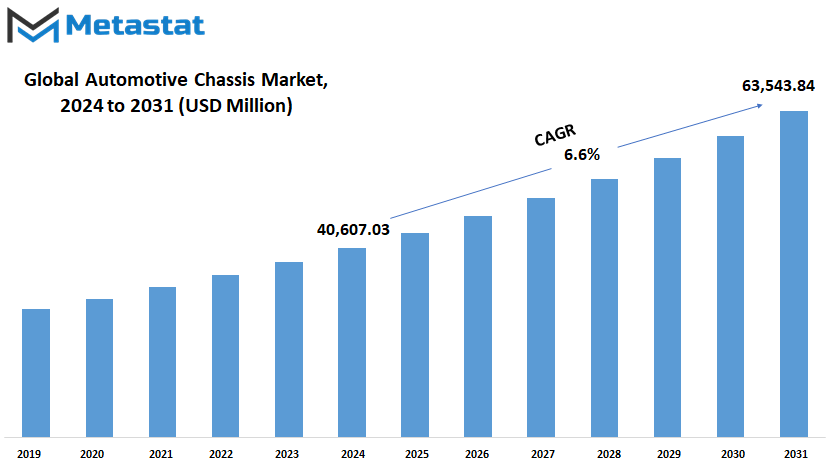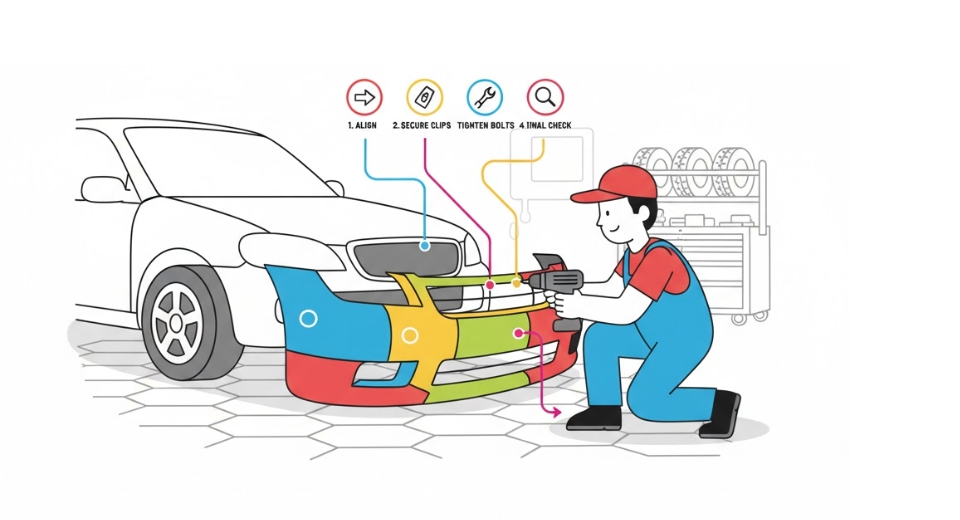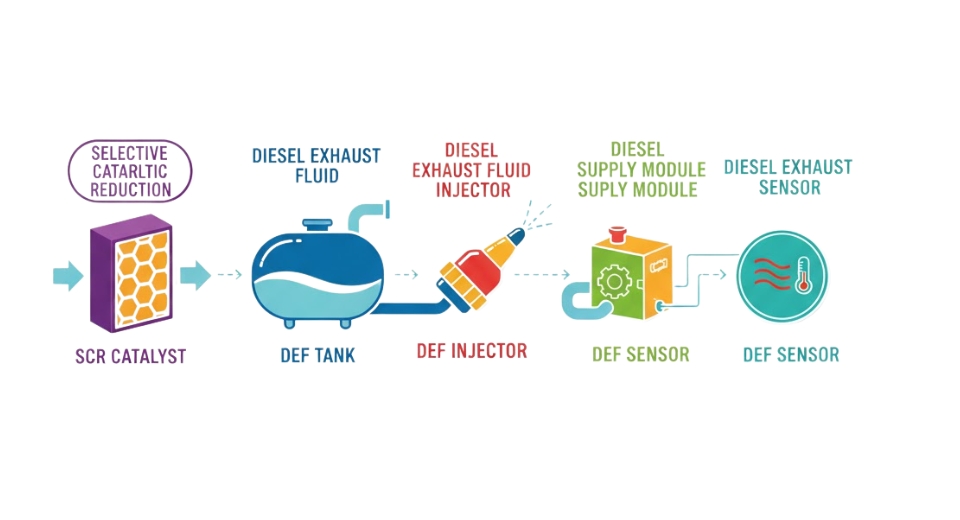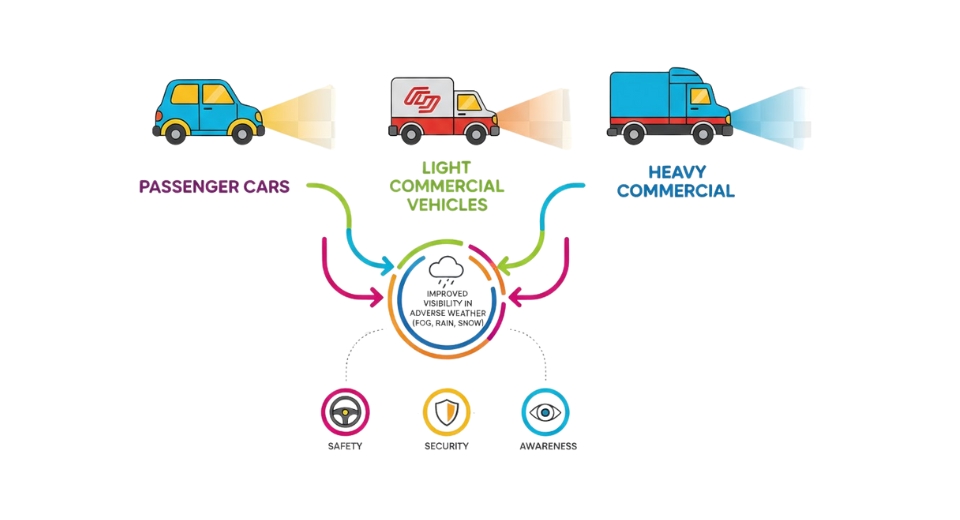MARKET OVERVIEW
The Global Automotive Chassis market is one of the dynamic and critical segments in the automotive industry that is supposed to grow further with new designs, safety measures, and new technological innovations in vehicle designs. The chassis of any vehicle is considered the foundation that represents the structure from which different parts of the engine, wheels, and body are mounted on.
Electric and autonomous vehicles would demand more than the usual required by the automobile industry leading to a change in material and technology of the chassis. The steel usage would completely be substituted by aluminum and composites, among other materials to have low-vehicle weight so that high fuel efficiency may be enjoyed. This revolution is, hence, inevitable because environmental regulations have been more stringent in this industry than ever, and customers are looking for eco-friendly vehicles. The evolution in chassis design will also revamp the market.
So, these changes will evolve in line with the safety, durability, and performance needs of times. All the advanced technologies like the active safety systems, sensors, and adaptive suspension system will be a part of the chassis structure. It will make vehicles better to drive and safer and more responsive to various conditions of roads. Geographically, the Global Automotive Chassis market is poised to expand further into prime areas like North America, Europe, Asia Pacific, and Latin America. As per growth in emerging markets like Asia Pacific, growth here would be huge since an increased demand for conventional vehicles along with electric ones was anticipated. Manufacturers most probably target these areas where there is a growth of the middle class with high requirements for affordable, yet efficient vehicles.
At the same time, consolidated markets in Europe and North America will continue to target high-performance and luxury-vehicle demand that will further accentuate demand for more and more sophisticated chassis technologies. The Global Automotive Chassis market is apt to see significant changes owing to adapting to new technology, changing consumer demands, and regulatory pressures. This market will be guided and formed by alterations in the materials, designing, and manufacturing processes toward making it far more performance based, safety-oriented, and sustainable vehicles. The entire concept of electric vehicles as well as autonomous driving goes to imply that the importance of a chassis will hold on throughout the next era of developments in the motor vehicle.
Global Automotive Chassis market is estimated to reach $63,543.84 Million by 2031; growing at a CAGR of 6.6% from 2024 to 2031.

GROWTH FACTORS
The Global Automotive Chassis market is undergoing rapid change. However, this kind of change comes with strong growth factors and several key triggers. The initial growth driver is the emerging demand for chassis materials on a lightweight note. Given the rising competition in developing fuel efficiency to reduce carbon footprint, manufacturers and automakers are now focused on materials that weigh much less or are made out of aluminum or carbon fiber. Cars would experience better fuel mileage with lower emissions due to decreased material weight. As tighter regulations by the government concerning fuel efficiency and emission coming from all over the globe are developed, it will be projected that companies will conceptualize lighter and greener products. Vehicle safety and crashworthiness also increase: Another significant reason that supports the growth of the Automotive Chassis market is increased stress on vehicle safety and crushworthiness.
This also increases the focus of consumers and regulators on the safety of vehicles, with heavy investments in the structural integrity of chassis by the automaker. The development of more sophisticated safety features such as collision prevention systems, adaptive safety zones, and designs with impact resistance is more significant in the development of the chassis. The requirement for high-performance chassis material will increase because the force experienced in crashes will increase with vehicle integrity. Despite these positive growth drivers, some obstacles could hinder the advancement of the market. These may include economic uncertainties across nations that continue to weigh heavily on automotive sales across borders.
Fluctuations in fuel prices, the sudden change in consumer preferences, or even economic slowdown can eventually impact the demand for a vehicle, which also ultimately affects the demand for its chassis. Furthermore, the strict government regulations on emission and fuel efficiency put further pressure on manufacturers to spend on new technologies and materials, which increases the production cost and may limit growth in the market. The future, however, for chassis design and manufacturing is all about integrating advanced technologies, and the emergence of EVs and autonomous driving will change the way chassis designs are done and manufactured. For example, electric drivetrains will need specific structural design to accommodate battery packs to maximize overall performance. Autonomous driving technologies will demand chassis designs to have installed a variety of sensors, cameras, and communication systems that are deemed critical to self-driving operations.
Therefore, such a trend will become an opportunity for those companies that are better positioned to innovate and address the shifting needs of the automobile industry. Though the Global Automotive Chassis market is being presented with various challenges, its growth will definitely be speeded up due to higher demands for lighter materials, greater safety standards, and further implementation of modern technologies in the future. It will likely be drastically altered in the near future due to the changes within the dynamic automobile industry in the way that manufacturers search for new materials and designs.
MARKET SEGMENTATION
By Chassis Type
The global automotive chassis market is expected to grow in leaps and bounds in the years to come. Technological advancement, change in consumer preference, and high demand for vehicles that offer higher performance, safety, and efficiency are the principal reasons behind this growth. Chassis provides the basic structure of a vehicle, supporting a number of parts and giving the whole vehicle structural integrity. Over the past years, a few chassis types have been more conspicuous in offering their respective advantages as they addressed the requirements of specific markets. The varieties in chassis include the Backbone Chassis, Ladder Chassis, Monocoque Chassis, and the Modular Chassis. The Backbone Chassis is one of the widely used chassis designs and approximated at about 5,627.04 USD million.
It has a central backbone which supports the vehicle's engine, suspension, and other vital parts. Such kind of chassis is characterized with its simplicity and durability; that is why it attracts high attention from cost-conscious consumers and manufacturers. Its design can be easily modified, making such chassis popular for use in most specialized vehicles, especially those that are off-road or otherwise and some electric vehicles. It's an Ladder Chassis, and that has a value in the market at about 3,047.28 USD million. These are commonly used in heavier vehicles like trucks and SUVs.
It is a ladder chassis type, but it is created from two parallel rails coupled together with cross-members. It provides very good strength and rigidity. It's quite suitable for heavy load vehicles or for ones that have to take some beating of driving conditions. The Ladder Chassis design is simple and cheap, and hence it is widely used in many industrial applications. The Monocoque Chassis is the most demanded in the automotive industry, particularly for passenger cars, and is valued at 22,272.63 USD million. It is quite unique compared to other designs because it integrates the body and chassis of the vehicle into one piece.
This reduces the weight and improves crash safety, hence its popularity among modern vehicles that focus on fuel efficiency and occupant protection. As automobile manufacturers consider reducing vehicle weight for better mileage and low emissions, it is also expected that growth will occur in the market for the Monocoque Chassis. Lastly, Modular Chassis, at the value of 9,660.08 USD million is flexible in design. It can apply its good variety of vehicles, regardless whether it is small in size or large in size. This flexibility made it the most popularly used in the automotive industry because manufacturers attempt to streamline their processes, thereby trying to produce variations of cars in reduced cost as well as trying to be readily adaptable to variations in requirements in the marketplace. In future, when technologies advance the global automotive chassis will acquire new dimensions.
More ever, chassis manufacturers shall deliver consumers with more and efficient use of fuel for safer vehicles with less destruction for the environment. More performance and sustainability with integration and embedding with new technologies will mark performance, fulfillment, or duty, each of the kinds. This market has tremendous growth opportunities, and it is here to stay in the automobile world of the globe.
By Material
Global Automotive Chassis market has been one of the important constituents of the auto industry. It contributes to the structural performance of a vehicle, and even more importantly, the performance of safety. Over the course of several decades, there has been an ever-changing process of the chassis' materials. Improvement in technologies, the requirement of being sustainable, and preferences that consumers have are among those factors. Among the materials used in car chassis, steel, aluminum, carbon fiber, and composite materials dominate the future of the market. It will be more dominant in the future as the market advances and changes according to upcoming trends in the automotive market.
The material with the longest usage period in automobile chassis manufacture is steel because of its strength, durability, and cost-effectiveness. It provides the structural integrity and safety that car manufacturers focus on in the design of their vehicles.
However, lately, with the rising environmental concerns and increasing demand for fuel efficiency, alternatives to steel have been in high demand. In the years to come, aluminum is to be in great demand for the market as its properties weigh light, and these would reduce the overall vehicle weights and improve the overall efficiency of fuel. Another strength of aluminum is its corrosion resistance, therefore suitable for manufacturers who aspire to produce vehicles with better lifespans. On the other hand, carbon fiber is turning out to be a game-changer in the automotive sector. Carbon fiber is gradually turning into a more viable option for high-performance cars as it has its properties lightweight and high strength. Since electric cars market will become more buoyant with growing times, carbon fiber is the need of the future in reducing the weight of that vehicle to extend battery life. It is pretty costlier at current pricing; but due to mass production and economies of scale, it is going to be relatively very affordable for the mass markets within a few years ahead. Composite materials are a giant leap in the market for the automotive chassis.
These are typically a mixture of plastics, fibers, and resins. Therefore, this delivers an excellent weight reduction/strength/cost balance. Composite materials already appear on some high-end vehicles. As the manufacturers refine the processes to make this material, the composite materials are also quite likely to be used on standard models. The composites are going to play a very big role in the quest by automobile companies to achieve more light and efficient cars but will ensure safety and performance levels are achieved. New materials and production techniques characterize the innovations in the Global Automotive Chassis market for the near future.
The adoption of aluminum, carbon fiber, and composite materials will increase in the automotive chassis sector due to the fact that more people are becoming inclined towards safer, efficient, and environmentally friendly vehicles. The Global Automotive Chassis market is one of the most important parts of the auto industry.
It contributes to the structural performance of a vehicle and, even more importantly, the performance of safety. During many decades, chassis materials are evolving. This involves the factor of improving in technologies, the requirement for being sustainable, and even the preference that consumers hold. In the case of materials applied for a car chassis, these materials such as steel, aluminum, carbon fiber, and composite materials are dominated for the future of the market. As the market proceeds and transforms according to forthcoming trends of the automotive market, it will be even more dominated by these. Steel has been used for the longest period in the manufacture of an automobile chassis because of the strength, durability, and cost-effectiveness of this material. It provides the necessary structural integrity and safety that automakers focus on in vehicle design.
However, with the rising environmental concerns and increasing demand for fuel efficiency, lately, alternatives to steel have been in high demand. In the years to come, aluminum is going to be in great demand for the market as its properties are lightweight, and these can reduce the overall vehicle weight and improve the overall fuel efficiency.
Another benefit of aluminum is the fact that it is corrosion-resistant. For such manufacturers who seek a lifetime vehicle, they look toward the use of aluminum. Carbon fiber is increasingly becoming the potential next best option for performance vehicle options as it possesses excellent high-strength yet relatively low-density properties.
As the electric vehicles market becomes more buoyant, the carbon fiber would be the more critical need for eliminating the weight of that vehicle to prolong the battery's life. It is more expensive at today's prices but mass production and economies of scale will make it that much cheaper for the general market in a few years. Composite materials are taking giant steps in the automotive chassis marketplace. The composite materials have already appeared in some expensive models.
As the makers perfect the process to produce the material, the composite material is also very likely to become a staple in the entry-level models. It will have a very big role to play in the pursuit by automakers to reach more light, efficient cars but still maintaining safety and performance standards. Future innovations in the Global Automotive Chassis market will feature innovation since manufacturers are seeking new materials and production methods. Shifting to safer, more fuel-efficient and greener automobiles would in return increase the utilization of aluminium, carbon fibre, and composites material use in automotive chassis.
By Vehicle Type
The Global Automotive Chassis Market is a vital component of the automotive industry. This basically forms the foundation upon which the design and safety elements of a vehicle rest, and is integral in developing vehicles ranging from simple, entry-level models to state-of-the-art automobiles. The market is advancing steadily with technology, the desires of the consumers, and the growing demand for environmental-friendly transportation. The future of the Global Automotive Chassis market appears bright, with emerging trends determining its growth.
The Global Automotive Chassis market has been categorized into various segments based on vehicle type: Passenger Cars, Commercial Vehicles, Electric Vehicles, and Hybrid Vehicles. These are the categories that show different needs and preferences of customers and rapid changes in the technologies of vehicles.
Passenger cars are the most significant market segment, and it is expected to be followed by this trend in the future. With people who are more dependent on personal transportation, the demand for lightweight, efficient, and safe chassis for passenger vehicles will increase. During the next few years, innovation in materials such as high-strength steel, aluminum, and carbon fiber would result in lighter and fuel-efficient chassis, making a better performance and safety aspect of passenger cars. More environmentally friendly and efficient cars will be a driving force for innovations in chassis design and manufacturing, which will be an integral part of the vehicle’s overall efficiency.
The commercial vehicle segment, which includes trucks, buses, and other large vehicles, is another important area within the Global Automotive Chassis market. With growing demand for goods and services globally, the commercial vehicle market will continue to expand. Manufacturers will produce more rugged and strong chassis in commercial vehicles, considering their use to bear heavy loads and cross long distances. Alongside this, growing environmental consciousness will see more use of lightweight and energy-efficient material in the vehicle, therefore making it not only less harmful to the environment but also less costly to use.
Electric and hybrid vehicle will be the future. With governments pushing for greener alternatives to traditional combustion engines, the demand for electric and hybrid vehicles is likely to grow rapidly. These vehicles will be designed to have advanced battery systems in the chassis while maintaining strength and safety. Innovations in chassis design will also be needed to support further adoption of EVs and hybrids, including lightweight structures and materials that improve energy efficiency and overall vehicle performance.
The Global Automotive Chassis market is changing to respond to the needs of new transportation. Whether it be for passenger cars, commercial vehicles, or the emergence of electric and hybrid models, chassis manufacturers are improving their products to make automobiles safer, more efficient, and environmentally friendly. In this regard, the industry will continue to play a vital role in the growth of the automotive industry and ensure that vehicles meet consumers’ changing needs and the needs of the planet.
By Chassis Components
The global automotive chassis market is expected to face significant changes in the future years due to the incorporation of technological advancements, changes in consumer needs, and high emphasis on sustainability. In any vehicle, the chassis is the base and critical for both performance and safety; with many components making it work, the market should grow as demand for electric vehicles and advanced driver-assistance systems increases.
An automobile chassis would primarily consist of a frame, suspension system, steering system, braking system, and wheels and tires. These components are key parts to making a car ride. The frame basically provides a skeleton that the entire componentry hangs on; meanwhile, the suspension system would serve as the body, where all shocks and impacts could be absorbed and absorbed into it for smoother driving experience. The steering system, on the other hand, provides control over the vehicle's direction. Meanwhile, the braking system is crucial for safety, offering the necessary stopping power in a variety of conditions. Finally, wheels and tires are the only parts of the vehicle in direct contact with the road, significantly influencing traction, handling, and fuel efficiency.
In the future, the automotive chassis market is going to change as more emphasis is put on innovation. Some of the changes in the coming years will be the wide adoption of lightweight materials, such as aluminum and carbon fiber, to reduce vehicle weight, making them more fuel efficient. The push towards electric vehicles is accelerating the adoption of such trends. These cars will need to use energy efficiently, and light-weight chassis will be needed for battery life extension. In addition, advanced suspension systems like air suspension and adaptive suspension will offer greater comfort and control to the driver in high-performance vehicles or electric cars. The steering system also is expected to benefit from further automation and electrification, with more cars becoming steer-by-wire units, which eliminate traditional mechanical linkages.
For sure, the braking system becomes essential for safety and a developed regenerative braking in electric vehicles to recharge while braked. As for the wheels and tires, an advanced material and design from tire will be developed regarding increased traction, performance and the lifetime of tires, though on rolling resistance to benefit the energy-efficient vehicle.
The global automotive chassis market has entered into a phase where great transformation is expected from vehicle manufacturers in order to cater to the needs of tomorrow-adequate safety features, high performance, and environment friendly. As this product grows, the demand will come with innovation in the form of materials, designs, and technology, making for huge growth and development prospects for the years to come.
|
Forecast Period |
2024-2031 |
|
Market Size in 2024 |
$40,607.03 million |
|
Market Size by 2031 |
$63,543.84 Million |
|
Growth Rate from 2024 to 2031 |
6.6% |
|
Base Year |
2022 |
|
Regions Covered |
North America, Europe, Asia-Pacific Green, South America, Middle East & Africa |
REGIONAL ANALYSIS
Global growth for the automotive chassis market will be tremendous, primarily based on technological advancements, an increased demand for electric vehicles, and a greater concern for vehicle safety. Knowledge of regional dynamics for this market will be crucial to understanding where this growth will most likely occur in the future.
North America encompasses the United States, Canada, and Mexico, who dominate the market in that region. The U.S. is still a major player in the automotive industry, but more sustainable solutions are the focus, especially in electric vehicle (EV) areas, which will likely boost the demand for lightweight high-performance chassis systems. In this regard, Canada and Mexico also contribute to growth with Mexico becoming a hub of manufacturing for automotive production. The North American automotive chassis market will benefit from ever-increasing investments in the research and development sector coupled with policies to reduce carbon emissions.
Europe, wherein the UK, Germany, France, and Italy head the pack, has transitioned steadily toward greener automotive solutions. Strict environmental regulations of the European Union will further drive up research in developing lighter, efficient chassis systems that could withstand the increased number of electric and hybrid vehicles on roads. Germany, one of the largest automotive manufacturer hub in the world, is sure to be ahead while others such as UK and France would contribute towards growing demand in the market due to increased demand for greener vehicles. As the automotive industry leans towards autonomous vehicles, the need to have chassis systems designed towards supporting advanced driver-assistance systems (ADAS) will also rise in the European region.
The emerging countries of Asia-Pacific-including China, Japan, South Korea, and India-will dominate the scenario of the future automotive chassis market. The demand for all forms of vehicles in this largest automobile market will therefore be driving both traditional as well as electric vehicle forms. An increasing emphasis toward sustainability coupled with rapid expansion in the adoption of electric mobility within the region shall boost advanced chassis systems developments. In Japan and South Korea, which are robustly set up with high volume automobile manufacturing, such development in lightweight and very durable chassis solutions will therefore experience growth. India, where the automotive sector is witnessing a boom, will boost the market due to a rising demand for affordable fuel-efficient vehicles.
South America, comprising Brazil and Argentina, is an area wherein the automotive chassis market would experience moderate growth. As it is not as massive as other regions, a growing automotive industry in South America will call for chassis solutions that support both traditional and emerging types of vehicle. The Middle East and Africa will be demanding automotive chassis as the respective regions continue to invest in infrastructure and urbanization. As such, the growth in sales of vehicles increases demand for high-quality and durable chassis systems. Such countries are expected to contribute significantly to this growth; among them are the UAE, Saudi Arabia, and South Africa.
It will keep on evolving: each region in its individual way adding to the sum of growth in the worldwide market for automotive chassis. North America and Europe are going to focus on innovations and sustainability, whereas the Asia-Pacific region will become a global leader in mass production and adoption, more so for electric vehicles. South America and the Middle East & Africa will eventually develop their automotive sectors; hence the market will start spreading more and more internationally. Advancements in material, design, and sustainability will determine the future of the automotive chassis market and will have a great significance in every region's role in developing it.

COMPETITIVE PLAYERS
The Global Automotive Chassis market will undergo considerable change in the near future, and this is when key players in the industry will be more than instrumental in its growth. Companies are looking forward to strengthening their product portfolio and innovating to serve the increasing demand for high-performance, lightweight, and sustainable chassis systems in the automotive sector. As the automotive world is moving toward electric and autonomous, the importance of the chassis is increased more. Now, it's not only about carrying the weight of the vehicle but also it has to bear new technologies and give more performance, safety, and sustainability.
Among the giants in this market, Magna International Inc. holds a paramount position as the global leader. With its knowledge in car body, chassis, interior components, and systems in varying degrees, Magna persists in shaping the landscape for high-performance and lightweight adaptive chassis systems to emerge at the industry's varying need. Continental AG takes significant importance in innovation related areas of lightweight materials along with advanced suspension systems focusing upon the improvement of better-handling vehicles that do little more than cut into some extra weight.
Other companies that will define the future of the automotive chassis market include ZF Friedrichshafen AG and Aisin Seiki Co., Ltd. ZF has been focusing on electrification and autonomous driving technologies and will lead the demand for more advanced chassis systems to be used with these next-generation developments. Aisin Seiki, on its part, has been developing components for the next generation of vehicles with a focus on durability and cost-effectiveness.
Some of the key players which would continue to drive innovation in the chassis market include Benteler International AG, Schaeffler AG, and CIE Automotive. These companies are highly focused on creating lighter, stronger, and highly efficient chassis designs for conventional as well as electric vehicles. Also, ThyssenKrupp AG and Hyundai Mobis are at the forefront of delivering next-generation chassis components that can improve performance and safety features.
As the market develops, so will other leaders in its development, which are also important for its implementation such as Gestamp Automoción, F-Tech, KLT Auto and JTEKT Corporation through the introduction of high-manufacturing methods and solutions of materials in all areas of vehicles with more frequent use of sophisticated chassis structures.
Moving forward, Dana Incorporated and REE Automotive will lead the way in advanced automotive chassis technology, opportunities for electric vehicle platforms and modular designs. Their efforts will play a significant role in transforming how chassis will be constructed and integrated in the design of future vehicles to achieve the flexibility that new vehicle types and new driving technologies require.
These competitive players ensure that the Global Automotive Chassis market is moving day after day, incorporating innovation in design and other such solutions that reshape the face of the automotive future.
Automotive Chassis Market Key Segments:
By Chassis Type
- Backbone Chassis
- Ladder Chassis
- Monocoque Chassis
- Modular Chassis
By Material
- Steel
- Aluminum
- Carbon Fiber
- Composite Materials
By Vehicle Type
- Passenger Cars
- Commercial Vehicles
- Electric Vehicles
- Hybrid Vehicles
By Chassis Components
- Frame
- Suspension System
- Steering System
- Braking System
- Wheels and Tires
Key Global Automotive Chassis Industry Players
- Magna International Inc.
- Continental AG
- ZF Friedrichshafen AG
- Aisin Seiki Co., Ltd.
- Benteler International AG
- Schaeffler AG
- CIE Automotive
- ThyssenKrupp AG
- Aisin Seiki
- Hyundai Mobis
- Gestamp Automoción
- F-Tech
- KLT Auto
- JTEKT Corporation
- Benteler Automotive
- Dana Incorporated
- REE Automotive, Ltd.
WHAT REPORT PROVIDES
- Full in-depth analysis of the parent Industry
- Important changes in market and its dynamics
- Segmentation details of the market
- Former, on-going, and projected market analysis in terms of volume and value
- Assessment of niche industry developments
- Market share analysis
- Key strategies of major players
- Emerging segments and regional growth potential








 US: +1 3023308252
US: +1 3023308252






